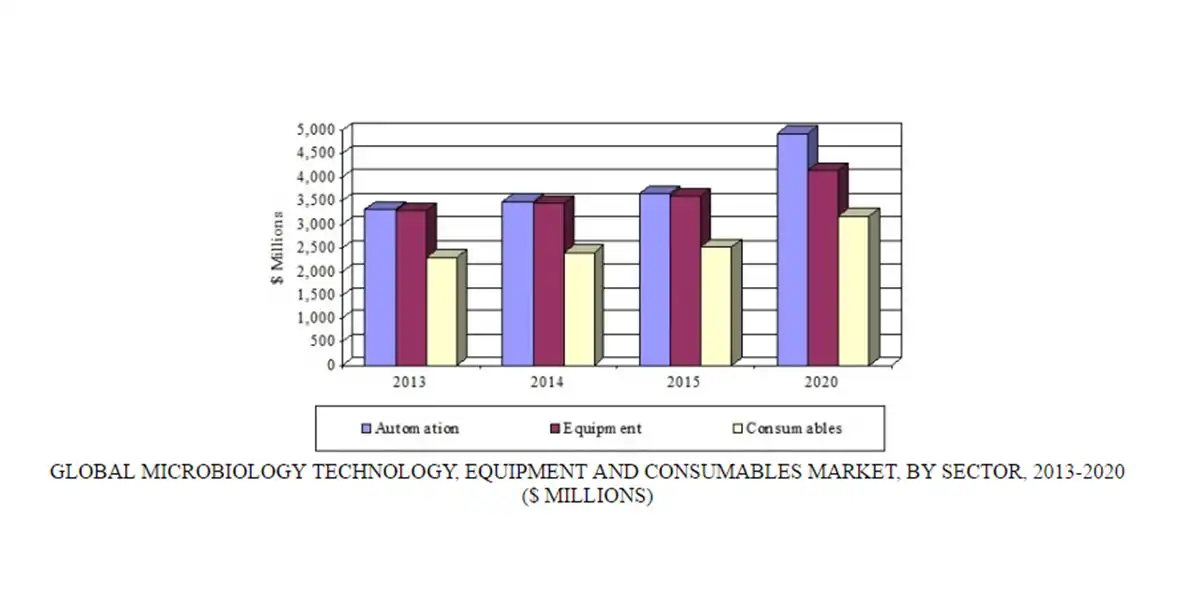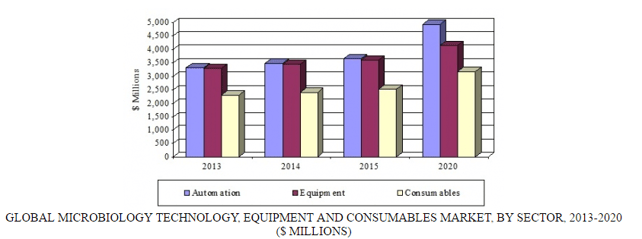
Oct 12, 2016
Blog Life Sciences Food Safety, Environmental Concerns Driving Global Microbiology Market
Increased concerns about food safety are pushing the development and adoption of new technologies in food microbiology. Issues with the difficulty of processing food specimens are also encouraging advances within the field. From new sample processing techniques and novel molecular technologies, to the increased use of biosensors, food microbiology is becoming much more technically sophisticated. Millions of illnesses and more than 1,000 deaths every year in the United States are attributable to foodborne illness caused by known pathogens, according to the Centers for Disease Control and Prevention.
FOOD SAFETY TESTING REQUIRES A FAST RESPONSE
When it comes to testing food samples, time is of the essence. Commonly used methods to test food for microbes can take up to 24 hours to get results, which is often too slow to catch tainted products before they reach the consumer. Faster methods exist, but have limitations. Magnetic resonance, for example, can detect extremely low levels of bacteria, but loses its effectiveness at higher bacteria concentrations. Fluorescence is the opposite, which is why researchers at Pittsburg State University (PSU) wanted to combine the two techniques to make a better detector.
The PSU scientists developed a hybrid nanosensor to detect bacterial contamination from Escherichia coli or other pathogens at concentrations as low as one colony-forming unit. In addition, it can do it faster than existing methods. Conventional bacterial detection methods, for example polymerase chain reaction (PCR), are useful, but require sophisticated instruments and extensive sample preparation and have long readout times.
As recently described in ACS Infectious Diseases, the nanosensor uses a combination of magnetic relaxation and fluorescence measurements to detect and quantify broad-spectrum contaminations in samples. In lab tests of milk samples, the nanosensor could detect varying concentrations of a pathogenic strain of E. coli in less than an hour. In addition, the researchers said the device could be customized to detect a wide range of pathogens besides E. coli.
THE ENVIRONMENT BOOSTS THE MICROBIOLOGY MARKET
Growth in environmental microbiology is driving the global market for microbiology technology, equipment, and consumables. In its recent report, BCC Research revealed that new technologies are facilitating simpler methods of handling samples, while the potential of biosensors is making this field less labor-intensive and not as time-consuming. In turn, these factors are encouraging the expansion of microbiology technology applications for environmental monitoring. Indeed, environmental monitoring has developed into a major business, with companies consulting for industrial concerns such as industry, public works, utilities, and real estate.
“Environmental microbiology has become a part of the skill set of these firms, allowing them to effectively deploy their skills to meet their clients’ needs,” says BCC Research analyst Todd Graham. “For example, bioremediation, or using bacteria to remove toxic chemical contamination from soil and water, has become a major environmental microbiology application. With applications in such well-known cases like the Deepwater Horizon oil spill in the Gulf of Mexico, this technique will be a part of environmentalists’ toolkits for a long time to come.”
The global market for microbiology technology, equipment, and consumables, which reached $9.8 billion in 2015, should approach $12.3 billion by 2020, reflecting a five-year compound annual growth rate (CAGR) of 4.6%. As a segment, automation and technology was nearly $3.7 billion in 2015 and is predicted to exceed $4.9 billion in 2020, at a five-year CAGR of 6.1%. The equipment segment totaled $3.6 billion in 2015 and is expected to surpass $4.1 billion in 2020, demonstrating a five-year CAGR of 2.8%. The consumables segment, valued at $2.5 billion in 2015, is expected to reach $3.1 billion in 2020 at a five-year CAGR of 4.7%.
GLOBAL MICROBIOLOGY TECHNOLOGY, EQUIPMENT AND CONSUMABLES MARKET, BY SECTOR, 2013-2020

New technology, as well as newer uses of older technologies such as PCR, is driving growth of the clinical diagnostics segment. PCR is scaling down and becoming simpler to use. Automation in clinical diagnostics has led to falling costs for clinical microbiology, which in turn has reduced cost pressures—particularly cost per test—among healthcare providers.
Lower crude oil prices have limited the outlook for biofuel. However, government policy demands for renewable fuel have put a floor in the market, and many biofuel producers are pivoting toward petrochemicals traditionally produced as byproducts of the refinery process. Technologies in this field will also continue to benefit the industrial microbiology market as they get spun off from biofuels.
BCC Research’s study, Global Markets for Microbiology Technology, Equipment and Consumables, analyzes the current state, setbacks, innovations, and the future needs of the market. The report also examines the impact of this market on industries such as food safety, environmental, and pharmaceutical. Global market drivers and trends, with projections of CAGRs through 2020, are provided.
In today’s fast-paced biomedical world, researchers and pharmaceutical companies...

Radiopharmaceuticals represent a cutting-edge frontier in modern medicine, offer...

Implantable Remote Patient Monitoring (IRPM) devices are revolutionizing healthc...

We are your trusted research partner, providing actionable insights and custom consulting across life sciences, advanced materials, and technology. Allow BCC Research to nurture your smartest business decisions today, tomorrow, and beyond.
Contact UsBCC Research provides objective, unbiased measurement and assessment of market opportunities with detailed market research reports. Our experienced industry analysts assess growth opportunities, market sizing, technologies, applications, supply chains and companies with the singular goal of helping you make informed business decisions, free of noise and hype.